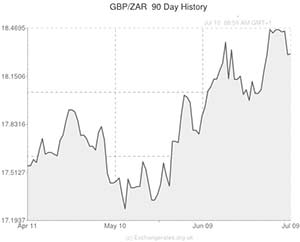
Before the release of South Africa’s Mining and Manufacturing Production reports the Pound to Rand exchange rate was trading in the region of 18.3500, up 0.25% on the day’s opening levels despite a less-than-spectacular trade balance report for the UK.
The Rand was also trending in a softer position against the US Dollar having advanced previously on the expectation that the strike in South Africa’s metal sector could soon be resolved.
Despite being a commodity-driven asset, South Africa’s currency was little affected by China’s trade figures for June.
The data detailed a 7.2% year-on-year gain in Chinese exports (up modestly from May’s 7.0% annual advance and well below the expected 10.4% increase) and a 5.5% year-on-year increase in imports.
While the Rand initially gained on the US Dollar following the release of very un-hawkish minutes from last month’s Federal Open Market Committee meeting, the USD/ZAR exchange rate clawed back losses and pushed to a high of 10.7223.
According to Barclays; ‘The Dollar […] weakened in the wake of the FOMC minutes, which ensured that the Rand maintained a firm bias overnight. These two international developments, together with (the hope) that National Union of Metalworkers of South Africa (NUMSA) members may be close to a wage settlement, lead us to believe that the Rand is likely to consolidate its recent gains, if not strengthen a bit further over the coming days.’
However, the Rand actually posted widespread declines on Thursday as investors reacted to South Africa’s Mining and Manufacturing Production reports.
Economists expected that mining production contracted by -1.8% on an annual basis in May, with manufacturing production also falling by -2.8% year-on-year.
However, the actual results were much worse, with mining production dropping by a whopping -6.5% in May, YoY, following a revised increase of 2.0% in April. On a month-on-month basis mining production slid by -3.1%. April’s monthly figure was revised to an increase of 6.3%.
Meanwhile, Manufacturing Production declined by -3.7% on a year-on-year basis and fell by -3.3% on a month-on-month basis.
These results are further proof of how severely the five-month long strike in South Africa’s platinum mining sector affected the economy and may spur workers within the metal sector to bring their own strike to a swifter conclusion.
Statistics South Africa ‘The largest negative contributions to the decrease [in manufacturing production were made by the following divisions: petroleum, chemical products, rubber and plastic products, motor vehicles, parts and accessories and other transport equipment and food and beverages.’
After the South African figures were published, the Pound to Rand (GBP/ZAR) exchange rate spiked to a high of 18.3900, though its gain was later regulated to just over 0.2%.
The Bank of England’s comparatively dull rate decision had little impact on GBP to ZAR trading. As expected by economists the central bank left rates on hold and policy unaltered.
There are also some influential economic reports for South Africa scheduled for publication next week, including the nation’s retail sales figures and the South African Reserve Bank’s interest rate decision.
On Friday the Pound to Rand exchange rate could fluctuate in response to the UK’s Construction Output report.
UPDATED 10:10 GMT 11 July, 2014
Pound Holds Advance Despite Disappointing Domestic News
Although the UK’s Construction Output report (due out Friday morning) was a bit of a flop, the Pound to Rand exchange rate managed to retain its 0.3% advance during the European session.
The appeal of the emerging-market Rand was quashed by the news that the National Union of Metalworkers of South Africa (NUMSA) rejected the latest wage increase offer, taking the strike in the metal working sector into an 11th day.
Yesterday’s South African Mining and Manufacturing reports demonstrated how much of an adverse impact the lengthy strike in the platinum mining sector has had on the local economy, and if this strike continues for much longer the economic situation is only going to worsen.
The Pound to Rand (GBP/ZAR) exchange rate is likely to hold its advance into the weekend.
South African Rand (ZAR) Exchange Rates
[table width=”100%” colwidth=”50|50|50|50|50″ colalign=”left|left|left|left|left”]
Currency, ,Currency,Rate ,
Pound Sterling, ,South African Rand,18.3558,
,South African Rand,18.3558,
Euro, ,South African Rand,14.6123,
,South African Rand,14.6123,
US Dollar, ,South African Rand,10.7276,
,South African Rand,10.7276,
Australian Dollar, ,South African Rand,10.0413,
,South African Rand,10.0413,
New Zealand Dollar, ,South African Rand,9.4201,
,South African Rand,9.4201,
Canadian Dollar, ,South African Rand,10.0474,
,South African Rand,10.0474,
[/table]

Comments are closed.